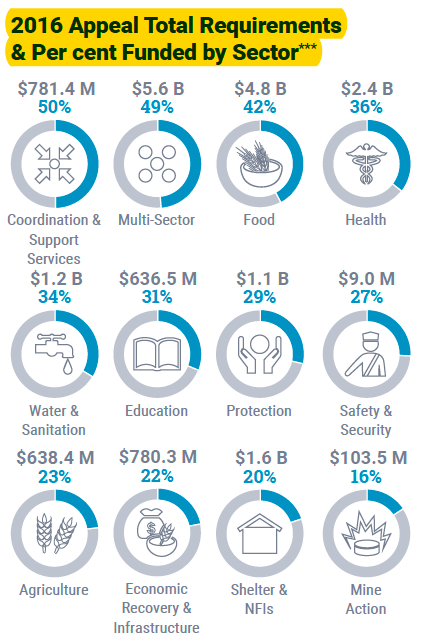Global Humanitarian Response 2017
Summary of overview1
A recent global humanitarian overview by the United Nations Office for the Coordination of Humanitarian Affairs (UN-OCHA) reports that, for 2017, humanitarian partners will require $22.2 billion to meet the needs of 92.8 million people in 33 countries (an increase from $20.1 billion for 87.6 million people in 37 countries in 2016). This is in stark contrast to the $2.7 billion called for in the first six inter-agency humanitarian appeals launched in 1992. The last quarter century has seen an overwhelming shift in frequency, scale and magnitude of humanitarian emergencies. Crises in Afghanistan, Burundi, the Democratic Republic of Congo (DRC), Somalia and Sudan have necessitated appeals almost every year. This has also been the case since the turn of the millennium for the Central African Republic (CAR), Chad, Iraq and the occupied Palestinian territory. The report includes a snapshot of the global humanitarian response for 2017, including country response plans, numbers in need and numbers predicted to receive aid.
These countries and many others are immersed in conflict and urgently require a multidimensional response. In Afghanistan, for example, needs are increasing due to massive displacement and protracted conflict. In Burundi, the political crisis continues to deepen and the number of people in need of urgent support has tripled to three million. About 1.2 million people, 80% of them women and children, have fled from South Sudan – the largest refugee movement in Africa. Aid organisations in Syria expect protection and humanitarian needs to grow exponentially if hostilities continue and no political solution is found. In the Lake Chad Basin, Boko Haram violence is causing instability and insecurity and there is little evidence that a political solution is forthcoming. Humanitarian access is severely constrained and has grown in complexity in countries including Iraq, South Sudan, Syria and Yemen. Mines, explosive remnants of war and improvised explosive devices further hamper humanitarian work and threaten the lives of those living in conflict-affected regions.
The report presents a breakdown of the 2016 overall global humanitarian funding ($20.4 billion) into percentages funded by sector (see Figure 1). Although nutrition is not presented separately, food insecurity and malnutrition will continue to drive humanitarian need.
Figure 1: 2016 appeal total requirements and percentage funded by sector*

*Includes 2.1 billion not yet assigned to a sector
Across the Sahel, hundreds of thousands of households live in unacceptably precarious conditions. Food insecurity, acute malnutrition, disease and disasters are a reality for millions. Conflict in the region and in bordering countries has uprooted many people from their homes and livelihoods and forced them into dependency on external assistance. Where chronic vulnerabilities drive humanitarian needs, humanitarians are collaborating with development actors to bring about a “shift from delivering aid to ending needs”. In 2017, transitional Humanitarian Action Plans for Burkina Faso, Mauritania and Senegal will be strategically aligned with resilience and development frameworks.
At the World Humanitarian Summit, the humanitarian community resolved to change the way it works in order to adapt to the changing operational context to meet the needs of affected people. Six countries will develop multi-year response plans in 2017 to allow partners to address needs arising from protracted crises more effectively. Multi-year planning and the Humanitarian Response Plans are designed to increase greater collective impact and accountability. The report includes summaries of 2017 Response Plans for 25 countries, as well as Refugee Response Plans for four regions.
United Nations agencies and partners are relying especially on non-earmarked and multi-year donor support to ensure timely response. Low, delayed and unpredictable funding with strict allocation criteria has serious consequences. In Ukraine, for example, inadequate funding has resulted in major delays, interruptions and discontinuation of critical activities such as mobile health clinics and services in hard-to-reach areas. Maintaining transport links for humanitarian relief for vulnerable people in Mali was seriously challenging in 2016. In Yemen, underfunding, outstanding pledges and bureaucratic impediments limit the reach of humanitarian partners. If sufficient funds are not secured for DRC, 4.3 million people will face heightened risk of morbidity or death due to malnutrition, food shortages and epidemics. Section 3 of the report highlights tools for supporting critical funding, such as the Central Emergency Response Fund (CERF) and the Financial Tracking System for tracking humanitarian aid flows.
In 2017, urgent humanitarian assistance will be required in Ethiopia, Somalia, Haiti and Southern Africa due to the El Niño event and its successor, La Niña. In Southern Africa, El Niño caused a 9.3 million-ton cereal production deficit and led to severe water shortages. Here and elsewhere, failure to act on the alarming crises outlined in this Global Humanitarian Overview could lead to a far wider humanitarian crisis, with devastating repercussions to life, livelihoods and security.
Footnotes
1 Global Humanitarian Overview 2017 (2016). United Nations Office for the Coordination of Humanitarian Affairs (UN-OCHA). www.humanitarianresponse.info/en/programme-cycle/space/document/global-humanitarian-overview-2017-consolidated-appeal-support-people


